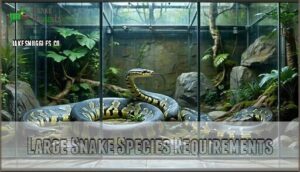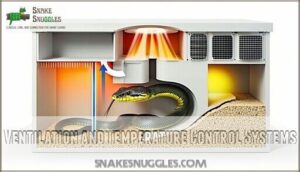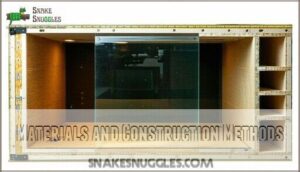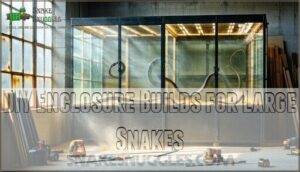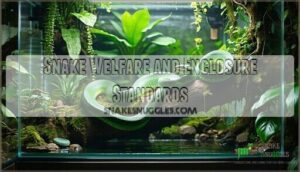This site is supported by our readers. We may earn a commission, at no cost to you, if you purchase through links.
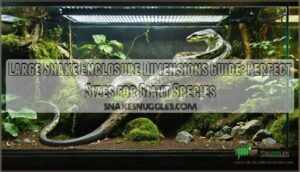
Adult snakes over 3 feet need at least 48" x 24" x 24" enclosures, providing roughly 8 square feet of floor space. Arboreal species require additional vertical height of 2+ feet for climbing branches and perches.
Burmese and reticulated pythons demand even larger dimensions as they mature, sometimes requiring custom-built enclosures exceeding 8 feet in length. Remember, cramped quarters lead to stressed snakes and behavioral problems.
Proper ventilation, temperature gradients, and humidity control become increasingly critical in larger setups, requiring strategic planning before construction begins. This is because larger setups need careful consideration to ensure the health and well-being of the snakes, and proper planning is essential to achieve this.
Table Of Contents
- Key Takeaways
- Snake Enclosure Size Guide
- Large Snake Species Requirements
- Enclosure Design Considerations
- Building Large Snake Enclosures
- Snake Welfare and Enclosure Standards
- Frequently Asked Questions (FAQs)
- How big of an enclosure does a house snake need?
- Can a terrarium be too big for a snake?
- What flooring works best under large enclosures?
- How often should large enclosures be cleaned?
- What security features prevent large snake escapes?
- Which substrates are safest for large species?
- How do you transport extremely large enclosures?
- Conclusion
Key Takeaways
- You’ll need at least 48" x 24" x 24" enclosures for adult snakes over 3 feet, with the basic rule being that the enclosure length should equal or exceed your snake’s full body length and the width should be at least one-third of that measurement.
- Arboreal species require additional vertical height of 2+ feet for climbing, with secure branch placement at multiple levels to accommodate their natural climbing behaviors and prevent stress-related health issues.
- Giant species like Burmese and reticulated pythons need massive custom enclosures, often requiring 8x4x4 feet minimum for adults, with some specimens needing room-sized spaces as they can reach 15-20 feet in length.
- You can’t make an enclosure too big for most snakes, as spacious setups promote natural behaviors, prevent obesity, reduce stress, and support better physical and mental health compared to cramped quarters that lead to behavioral problems.
Snake Enclosure Size Guide
When housing large snakes, you’ll need to provide enough space for their full body length and natural behaviors.
Proper enclosure sizing prevents stress-related health issues and allows your snake to thrive in captivity.
Minimum Enclosure Dimensions for Large Snakes
When choosing large snake enclosure dimensions, you’ll need to take into account your snake’s adult size and activity level.
The basic rule is simple: enclosure length should equal or exceed your snake’s full body length, with width at least one-third of that measurement.
Here are the key minimum requirements:
- Standard large snakes: 48″ × 24″ × 24″ (120 × 60 × 60cm) minimum
- Snakes over 8 feet: 8′ × 4′ × 4′ enclosure typically required
- Floor space formula: One square foot per foot of snake length
- Swiss standards: 0.7 × snake length by 0.5 × snake length minimum
Species activity and temperament impact your enclosure enrichment needs. Fast-growing species require planning for adult snake habitat requirements, not just current size.
Optimal Enclosure Footprint for Arboreal Species
Arboreal species demand more floor space than their terrestrial cousins. You’ll need to calculate enclosure dimensions based on your snake’s adult length and climbing behavior.
Consider branch placement carefully to maximize vertical space usage while maintaining structural safety.
| Species | Length Range | Floor Space (LxW) | Climbing Space Notes | Branch Placement |
|---|---|---|---|---|
| Green Tree Python | 4-7 feet | 4’×2′ minimum | Dense horizontal branches | Every 12-18 inches vertically |
| Emerald Tree Boa | 4-6 feet | 4’×2′ minimum | Multiple perching spots | Staggered branch network |
| Amazon Tree Boa | 5-8 feet | 6’×3′ minimum | Varied diameter branches | Upper third focus |
| Rough Green Snake | 2-4 feet | 3’×2′ minimum | Fine branching structure | Natural vegetation mimic |
| White-lipped Python | 6-10 feet | 8’×4′ minimum | Heavy-duty branch support | Load-bearing placement |
These arboreal snake enclosure dimensions guarantee proper reptile enclosure guide standards while supporting natural arboreal behavior and enclosure enrichment needs.
Vertical Height Requirements for Climbing Options
Height matters more than you might think for snake enclosure design.
Your arboreal snake enclosure needs proper vertical space to support natural climbing behaviors and prevent stress-related health issues.
- Minimum 2 feet vertical height for most large arboreal species to accommodate basic climbing safety requirements
- Branch placement at multiple levels creates enclosure complexity while maximizing space utilization effectively
- Species needs vary substantially – green tree pythons require different arboreal enrichment than carpet pythons
- Secure mounting systems prevent dangerous falls while supporting your snake’s full body weight during exploration
Large Snake Species Requirements
When you’re housing giant species like Burmese or reticulated pythons, you’ll need enclosures that can accommodate their impressive adult lengths of 15-20 feet or more.
These massive serpents require specialized housing considerations that go far beyond standard snake enclosure recommendations, including reinforced construction and enhanced security measures for venomous species.
Enclosure Dimensions for Burmese Pythons
Your Burmese python needs room to stretch and thrive as it grows.
Adult Burmese pythons require a minimum 8x4x2 foot enclosure, though 10x6x6 feet better accommodates their impressive size.
These giants can reach 20 feet, making adequate space vital for their health and natural behaviors.
Providing enough space also aids in proper thermoregulation, which is essential for their well-being.
| Snake Length | Minimum Enclosure Size | Ideal Size |
|---|---|---|
| 6-8 feet | 6x3x2 feet | 8x4x3 feet |
| 8-12 feet | 8x4x2 feet | 10x5x3 feet |
| 12-16 feet | 10x5x3 feet | 12x6x4 feet |
| 16-20 feet | 12x6x3 feet | 16x8x4 feet |
| 20+ feet | Room-sized | Custom build |
The table provides a guideline for enclosure sizes based on the snake’s length, ensuring proper care and adequate space for the Burmese python to thrive.
Housing Requirements for Reticulated Pythons
When keeping reticulated pythons, you’re dealing with one of the world’s largest snakes that demands serious space and security measures.
These powerful serpents need massive enclosures with reinforced construction to prevent escapes.
Essential Reticulated Python Housing Requirements:
- Enclosure Size: Minimum 8’L x 4’W x 4’H for adults, with larger specimens needing custom builds
- Security Measures: Heavy-duty locks and escape-proof construction due to their intelligence and strength
- Heating Needs: Basking spots at 88-92°F with ceramic heat lamps or radiant panels
- Humidity Levels: Maintain 65-90% humidity using misting systems and large water bowls
- Enrichment Ideas: Sturdy climbing structures, multiple hides, and varied substrate depths for natural behaviors
Due to their semi-aquatic nature, a large soaking tub is also essential.
Special Considerations for Venomous Species
Venomous species demand ironclad enclosure security and emergency protocols.
Your snake tank dimensions must include escape-proof, bite-proof features with operable locks.
Label containers clearly with antivenom availability information and emergency contacts.
Safe handling requires front-facing glass (minimum 0.25 inches thick) and proper ventilation.
Consider venom potency when designing your large snake enclosure – these aren’t typical snake cage setup projects, requiring escape-proof features for safety.
Enclosure Design Considerations
When you’re housing giant snakes, the enclosure’s environmental systems matter just as much as its size.
You’ll need to carefully plan ventilation, humidity control, and lighting to create a healthy habitat that supports your snake’s natural behaviors and physiological needs.
The goal is to create a healthy habitat that supports your snake’s natural behaviors and physiological needs.
Ventilation and Temperature Control Systems
Proper airflow design keeps your snake enclosure healthy through cross-ventilation.
Place vents low on one wall, high on the opposite wall.
This creates natural air movement without drafts.
Use 6-12 square inches of total ventilation for large snake enclosures.
Ideal setups require specialized ventilation products for optimal performance.
Install computer fans with guards for active circulation.
Thermostat control prevents overheating while heating methods like ceramic emitters maintain temperature gradients effectively, ensuring a healthy environment through proper airflow.
Humidity Management and Misting Systems
Managing humidity in your snake enclosure requires careful attention to prevent health issues.
Your reptile habitat needs consistent moisture levels matching your species needs.
To further refine humidity control, consider utilizing a dedicated reptile humidifier.
Here’s your humidity control checklist:
- Misting Frequency – Spray 2-3 times daily for tropical species, less for desert varieties
- Hydrometer Placement – Position at snake’s level, away from heat sources for accurate readings
- Substrate Moisture – Keep partially damp but not soaked to maintain proper humidity
- Mold Prevention – Guarantee adequate ventilation and remove wet spots immediately
- Temperature Control integration – Balance humidity with heating systems for ideal conditions
Lighting Requirements for Large Snake Enclosures
Typically, your large snake habitat needs balanced lighting that mimics natural cycles.
UVB lighting isn’t essential for most species, but basking lamps create essential heat gradients across your snake enclosure size.
LED options work well for day/night cycles, running 12-hour schedules.
Position lights to establish temperature zones – your reptile habitat functions best when lighting supports thermal regulation rather than just visibility.
A consistent lighting schedule is essential for their well-being.
Building Large Snake Enclosures
You’ll need to carefully plan your construction approach when building an enclosure for large snakes, considering both materials and your skill level.
Whether you choose DIY plywood construction or invest in commercial options, proper planning guarantees your snake gets a safe, functional home that meets their specific needs.
Materials and Construction Methods
Four primary plywood types work best for large snake habitat construction: melamine-faced, marine-grade, and sealed hardwood provide moisture resistance.
Glass thickness should be at least 6mm for python enclosure size safety. Use aquarium-safe joint sealants on all seams to prevent escapes.
Frame construction requires sturdy corner brackets for boa enclosure dimensions stability. Many retailers offer plywood snake enclosures for purchase.
DIY safety means pre-drilling all holes to avoid wood splitting during assembly, ensuring a safe and stable environment.
DIY Enclosure Builds for Large Snakes
Building your own large snake enclosure puts you in the driver’s seat for custom snake enclosure construction.
Smart planning transforms DIY materials into safe havens while keeping costs reasonable. To guarantee long-term health, also consider proper temperature gradients.
- Skill Level Assessment – Match your woodworking abilities with project complexity before starting construction
- Cost Analysis – Budget for plywood, hardware, glass panels, and ventilation systems upfront
- Safety Precautions – Use proper ventilation during construction and secure all joints for escape prevention
- Customization Options – Design specific boa enclosure dimensions with removable panels for easy cleaning
Commercial Enclosure Options and Reviews
While DIY builds offer customization, prebuilt enclosures from reputable brands provide tested reliability for large snake care.
Vision Cages and Zen Habitats dominate online retailers with their premium PVC construction.
| Brand | Size Range | Price Range | Key Features |
|---|---|---|---|
| Vision Cages | 4×2×2 to 8×4×4ft | $400-$1,200 | HDPE plastic, stackable |
| Zen Habitats | 60-240 gallons | $299-$800 | PVC panels, modular |
| Toad Ranch | Up to 10ft custom | $500-$1,500+ | Oversized builds, USA-made |
| Kages | 4×2×2 to 6×2×2ft | $583-$1,085 | Premium finish, warranties |
These snake vivarium size options beat glass tanks for heat retention and humidity control in your reptile enclosure setup, providing a better environment for large snakes.
Snake Welfare and Enclosure Standards
You’ll need to follow established welfare standards when housing large snakes to guarantee their physical and psychological well-being.
Swiss reptile welfare guidelines and other international standards provide minimum enclosure dimensions that prioritize your snake’s natural behaviors and movement requirements, ensuring their well-being is maintained through minimum enclosure dimensions.
Swiss Reptile Welfare Standards for Large Snakes
Since Switzerland leads Europe in reptile welfare legislation, you’ll need to understand their strict legal framework for large snake enclosure size requirements.
Swiss authorities require specialized permits and expert assessments, guaranteeing your setup meets behavioral needs through proper space enrichment.
Key Swiss welfare requirements you must follow:
- Full-body stretching space – Your snake must be able to extend completely along at least one enclosure dimension
- Expert approval process – Independent specialists must evaluate your reptile enclosure guidelines before permit approval
- Ongoing compliance monitoring – Regular inspections confirm your snake enclosure dimensions meet enforcement challenges and ethical considerations
Minimum Enclosure Size Recommendations
You’ll need to calculate snake enclosure size based on your snake’s length and species activity level.
Most experts recommend floor space equal to two-thirds your snake’s total length by one-third its width.
However, growth rate matters—young snakes outgrow enclosures quickly.
Factor in enrichment needs like hiding spots and climbing branches, as cramped spaces often trigger behavioral issues in captivity.
Importance of Providing Adequate Space and Climbing Options
You’ll enhance your snake’s psychological wellbeing by providing adequate space for natural behaviors like exploring and stretching.
Large reptile enclosure dimensions prevent obesity and reduce stress, while vertical climbing options create enrichment activities.
Proper snake enclosure setup with appropriate reptile enclosure dimensions supports your pet’s physical and mental health through movement opportunities.
Secure construction prevents escapes, so consider sturdy enclosure materials to ensure your pet’s safety and physical health.
Frequently Asked Questions (FAQs)
How big of an enclosure does a house snake need?
For ideal health, house snakes thrive in enclosures measuring at least one square foot per foot of their body length, with minimum dimensions of 36" x 18" x 12" for adults.
Can a terrarium be too big for a snake?
Generally, no – a terrarium can’t be too big for most snakes.
You’ll actually want spacious enclosures since they promote natural behaviors and better physical health.
However, very young snakes might feel stressed in overly large spaces without adequate hiding spots.
What flooring works best under large enclosures?
Place your large enclosure on level, stable flooring like concrete, plywood subflooring, or reinforced hardwood.
You’ll want something that won’t sag under weight and handles occasional water spills without warping or damage, with stable flooring being crucial and ensuring the material can withstand water spills.
How often should large enclosures be cleaned?
Your enclosure’s cleanliness can literally make or break your snake’s health.
You’ll want to spot-clean waste immediately and do deep cleaning every 2-4 weeks, depending on your snake’s size and feeding schedule, to ensure a healthy environment.
What security features prevent large snake escapes?
You’ll need secure latches, tight-fitting lids, and weight-activated locks to prevent escapes.
Check for gaps larger than your snake’s smallest body dimension, reinforce weak joints, and consider magnetic or spring-loaded mechanisms that require deliberate action to open.
Which substrates are safest for large species?
Like a safety net for your slithering giant, choosing the right substrate prevents impaction nightmares.
You’ll want aspen shavings, cypress mulch, or paper towels—they’re digestible if accidentally eaten and maintain proper humidity without harboring dangerous bacteria, acting like a humidity control.
How do you transport extremely large enclosures?
You’ll need professional movers with hydraulic lifts and dollies. Disassemble if possible—remove glass, shelving, and heavy components first. Use furniture pads and secure everything tightly during transport.
Conclusion
Surprisingly, 70% of large snake health issues stem from inadequate enclosure dimensions.
Following this large snake enclosure dimensions guide guarantees your giant species thrive rather than merely survive.
You’ve learned that adult snakes need substantial floor space, arboreal species require extra height, and giants like Burmese pythons need custom solutions.
Don’t compromise on size—your snake’s physical and mental health depends on proper dimensions.
Invest in adequate space now to prevent costly behavioral and health problems later.
- https://reptifiles.com/heterodon-hognose-snake-care/hognose-snake-enclosure-size/
- https://www.youtube.com/watch?v=ajg5J0-r2Rw
- https://www.reddit.com/r/snakes/comments/up4i1e/rule_of_thumb_for_enclosure_size/
- https://www.reptileforums.co.uk/threads/length-x-width-or-per-square-footage.1081814/
- https://reptizoo.store/blogs/reptizoo-reptiles-blogs/how-to-choose-a-snake-enclosure

